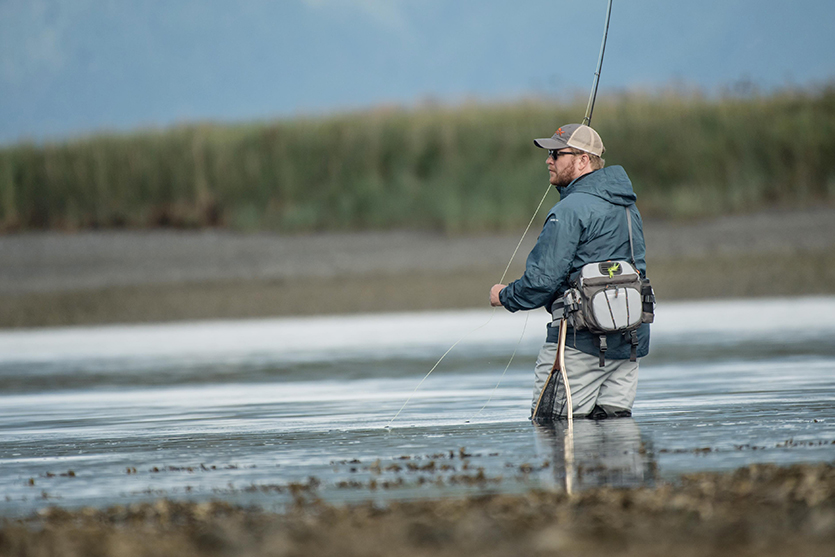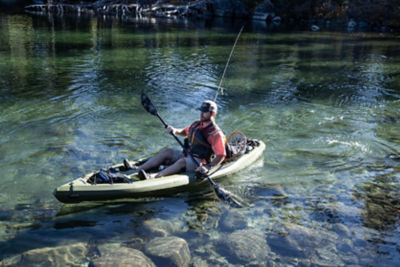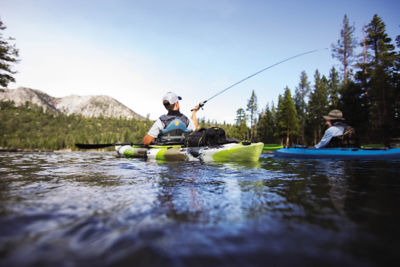How to Choose Waders
Take your fishing talents into the water with the right pair of fishing waders this season. Use these tips to determine the best wader style, material and height for your angling profile.

Whether tackling shallow streams or commanding rolling rivers, having a quality pair of fishing waders can significantly enhance your comfort and efficiency when out on the water. There are a number of options and styles available to anglers, and matching these qualities to your fishing conditions can help you find more enjoyment with each cast.
Waders can differ in terms of height, material and style, each with certain features designed for certain waterways. Use these fishing Pro Tips to help you put your best foot forward this fishing season with the right waders for your needs.
WADER HEIGHT
When choosing which fishing waders to add to your angling ensemble, think about the conditions where you’ll be casting. Will it be slow-moving water or a faster current? How deep will the streams be? To keep your line in the water no matter the environment, there are three main wader heights available: hip, waist and chest.
- HIP WADERS: Hip waders are the shortest available option for fishermen. Resembling a pair of chaps, hip waders feature two separate legs that strap to your belt to prevent them from falling down as you reel in your trophies.
Hip waders can be great for fishermen who only venture into shallow streams or creeks with slow-moving current, as they can comfortably protect against waters up to knee or lower-thigh height. This style can also be great to have on hand when launching boats, digging for clams and hunting in swampy conditions.
- WAIST-HIGH WADERS: Also called wading pants, this wading option gives fishermen a little more coverage than the previously mentioned hip wader. Resembling a baggy set of trousers, waist-high waders can be worn with either a belt or suspenders.
These are a fantastic option for anglers looking to get into mid-thigh-high water, as well as those looking for unrestricted motion for their upper half.
- CHEST WADERS: Despite being the tallest wader option available, chest waders are the most versatile choice for fishermen. This one-piece garment uses built-in suspenders to keep them in place and allows anglers to fish in river levels as high as their chest.
Chest waders can also be great when navigating new waters with unknown drop-offs and gullies, or streams with a faster current. Finally, chest waders can provide superior coverage, meaning that they not only can help tackle the river’s depths, but the weather conditions as well.
BONUS PRO TIP: Always keep safety on your mind and wear a wading belt to prevent your chest waders from flooding.
WADER MATERIALS
There are essentially three materials when it comes to fishing wader construction: neoprene, rubber and breathable nylon or polyester with a waterproof membrane. Each has advantages and disadvantages when choosing the best waders for your fishing needs. So, be sure to consider the fishing conditions you’ll most likely find yourself in to set yourself up for maximum comfort in the water.
- NEOPRENE: Neoprene is a great material for fishermen looking to fish in colder temperatures. Thicker than other options, neoprene waders can help with insulation and durability in rough waters. Thicknesses can vary, with 3mm being optimal for general fishing and 5mm better suited for colder climates.
While neoprene can be warm and comfortable, waders made from this material are not breathable. Some fishermen might find these waders too hot in warmer conditions and should opt for a more breathable option. Thicker neoprene can also hold some buoyancy, which can make trudging through streams a bit awkward.
BONUS PRO TIP: Neoprene waders can also be a great option for waterfowl hunters. Their insulation and durability perform fantastically in the marshes and swamps during hunting season, where you’re more likely to run into hanging limbs or other debris.
- RUBBER: Rubber waders are some of the most waterproof options for fishermen. Many waders use rubber components for this reason. These components are most seen in the boot portion of their construction.
Rubber is very resilient to tears and punctures, but it has little-to-no breathability and a lesser range of motion than other materials. As a result, it’s rare to find waist-high waders and chest waders made solely of rubber. Many hip wader options, however, can be found in this material and can be great for shallow-yet-rough waters.
- BREATHABLE WADERS: One of the more popular options among fishermen, breathable waders are often composed of nylon or polyester materials, along with a waterproof membrane. This option is very lightweight, versatile and available in all heights.
Breathable waders are perfect for warm days on the water, as they allow any perspiration or moisture to escape from the inside while keeping the exterior water out. These waders can even be used in colder conditions, provided that anglers wear an insulating, moisture-wicking base layer underneath.
One disadvantage to nylon or polyester waders, however, is that they’re not as durable as neoprene or rubber. They can be prone to tears and punctures, especially in stress points such as the knees and seat. Some models look to counter this action with added support and reinforcing material in these areas to prevent rips from occurring.
WADER STYLES
Finally, there are two style options when it comes to fishing waders. Anglers can either choose to go with a bootfoot wader or a stockingfoot wader.
BOOTFOOT WADERS: Bootfoot waders, also called barefoot waders, already have the boot sewn onto the foot. Because of this, there’s no need to purchase an additional pair of wading boots.
This wader style is easy to put on and take off and can help keep unwanted debris from getting into undesirable places like around your ankle or under a heel. Some drawbacks, though, are that bootfoot waders are often heavier than stockingfoot styles and there are no laces on the boot to customize the fit. Bootfoot waders can also come in rubber, felt or cleated soles.
- RUBBER: Dependable traction that resembles a hiking boot tread. Great for muddy conditions and a good all-around boot sole.
- FELT: Cloth-soled boot that provides exceptional traction in slimy, rocky conditions. Not as durable as rubber and can erode over time. Check with your local fish commission on the legality of felt-soled waders before purchase.
- CLEATED: Studded for extreme traction and stability. Fantastic at maneuvering through dead leaves and moss patches. They can be difficult to clean, however, once you’re finished for the day.
STOCKINGFOOT WADERS: Whereas bootfoot waders already have the boots attached to them, stockingfoot waders feature neoprene booties and are designed to be worn with separate wading boots. The seams of the neoprene booties keep your feet dry and warm, while the wading boots can provide optimal traction and support.
Stockingfoot waders are more lightweight than bootfoots, making them ideal for fishermen backpacking into their locations. There is also more room for customization with stockingfoots, as the separate wading boots can be tightened or loosened for that tailored fit.
Wading boots can also feature the same sole patterns as bootfoot waders with the option to pick and choose by pair, making it easier for fishermen to match their conditions for superior support. For more information on how to choose wading boots, click here.
ADDITIONAL FEATURES
You can also look for accessory features when choosing fishing waders. Chest pockets, D-rings, belt loops for wading belts and sewn-in knee pads can be great luxuries to have when out casting. One key feature that can be found in stockingfoot waders is additional gravel guards, which essentially work like normal gaiters and fold over the top of your wading boots to help prevent debris from entering the boot.
While none of these features are absolutely necessary to get the most out of your waders, they can come in handy when navigating your favorite fishing hole.
A WORD ON WADER SIZING
Wader sizes can be taken according to a number of measurements, such as chest, waist, hip, inseam and shoe size. Wader sizing can also vary by brand, so be sure to check with the manufacturer’s sizing chart before making a purchase.
Having the best waders for your fishing needs can help you land the big one this fishing season. Use these Pro Tips and grab a pair that matches perfectly with your angling outfit.








